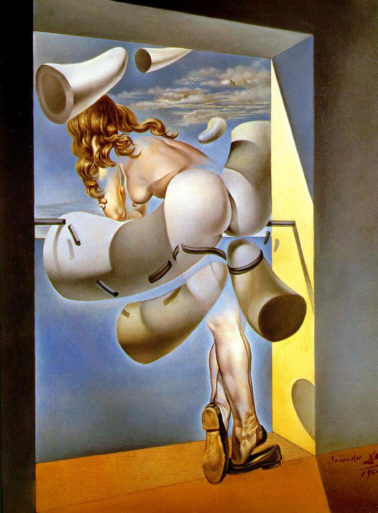
|
Salvador Dali’s astonishing portrait, Young Virgin Autosodomized by the Horns of her Own Chastity (1954). Dali asserted that he was the greatest artist world-wide for representation of the female posterior. |
CovertureSteve Moxon on traditional Anglo-Saxon marriage lawFrom The Woman Racket (2008) |
Coverture is the legal principle that a man must take responsibility for the actions of his wife, no matter how unreasonable. This has been presented as the creation of a female legal non-persona, but any adverse consequence for women was unusual and minor compared to the serious imposition on men. It can be understood only in terms of the conception of social justice at the time, that the family household, not the individual, was the locus of rights and duties. p.107
In the days prior to the notion that the individual reigns supreme, the functional component of society was the family household. This was underlined by the law of coverture that I explain below. The person who carried the can in the household (even though he did not reap the most benefits) was the husband, so naturally it was the man of the house who – if anyone could – voted on behalf of the whole household.
The concept of the family household as the unit in society rather than the individual, and of the sense of obligations as opposed to rights, is central to understanding the difference between attitudes concerning men-women in the past, compared to such attitudes nowadays. The sexes had different but complementary domains that couldn’t be compared. The woman ran and ruled the household and represented the household to the local community, whereas the man earned the money to make sure that the household could be run at all. For this effort he was granted admittance. From this perspective, it would be nonsense to compare the sexes in terms of rights, wrongs, privileges and duties (p.93).
Coverture was an unreasonable imposition on men
Coverture was bound up with the custody issue, being another facet of the view that the family household and not the individual was the unit of society. Husband and wife were treated as one entity, which meant that wives could not control their own property unless specific provisions were made before marriage. This seems pretty Jurassic even to the most non-feminist contemporary outlook, but there are ramifications that again put things in their true light. Perhaps the clearest description of what coverture meant was made in 1765 by Sir William Blackstone, in his Commentaries on the Laws of England:
By marriage, the husband and wife are one person in law: that is, the very being or legal existence of the woman is suspended during the marriage, or at least incorporated and consolidated into that of the husband: under whose wing, protection, and cover, she performs everything.
Legally, the husband was responsible for all actions of his wife, and he could be imprisoned on this basis. So, for example, if the wife’s expenditure brought the couple into debt, then the husband would be imprisoned, even though he was the breadwinner and had been the one who had built the financial liquidity of the household, and had in no way contributed to its bankruptcy. A wife could knowingly spend money she knew her husband did not have. Indeed, it was a legal obligation to provide a wife essentials on the offer by the wife of her husband’s credit, regardless of the consequences. Coverture gave carte blanche to vindictive wives literally to permanently ruin their husbands and condemn them to life imprisonment. In complete contrast, the wife was rendered immune to prosecution, because any criminal activity would be deemed to be under the husband’s direction, and he alone was then regarded as the one who had actually committed the crime. In time, this was refined to any crime committed in the husband’s presence, or any that in his absence the wife was coerced to do – and simply being told to do something was sufficient to be regarded as coercion. Coverture laws remained until well into the twentieth century. Some statutes exempted certain crimes, notably murder and treason. For example, in the USA, the Oklahoma Statutes of 1931 exempted under certain circumstances murder and treason and sixteen other crimes.
Modern interpretations of coverture pathologise what was in fact protection or chivalry. Coverture was the fiercest legal insistence that a man take responsibility for his family, no matter how wronged he may have been, and no matter how capable his wife was of taking full responsibility for her own behaviour (pp.105-106).
Note added
Moxon’s book is difficult in several ways. There was I think an account of lemur or other primate behaviour which was not borne out in the paper quoted. Nevertheless Moxon makes many devastating anti-feminist points, citing an abundance of evidence. The subject of coverture is important, since it was the norm in Anglo-Saxon populations for centuries.
In these passages (and apparently in the rest of the book) Moxon omits that a husband had certain limited privileges. He had, and was expected to exercise, authority. He had conjugal rights and the likelihood of progeny. Further, a logical consequence of the principle of coverture was that he had an obligation to keep his wife in line and punish her when necessary, since he was responsible for her actions, which could also affect others.
A husband had dominion over his wife, certainly in law. The traditional role in marriage is that the wife gives her husband the illusion of control while largely maintaining it.
Simon Sheppard
Nature has given women so much power that the law has very wisely given them little. Samuel Johnson, 1763
